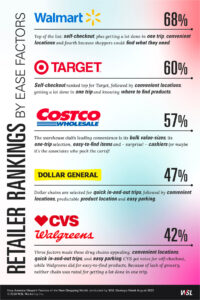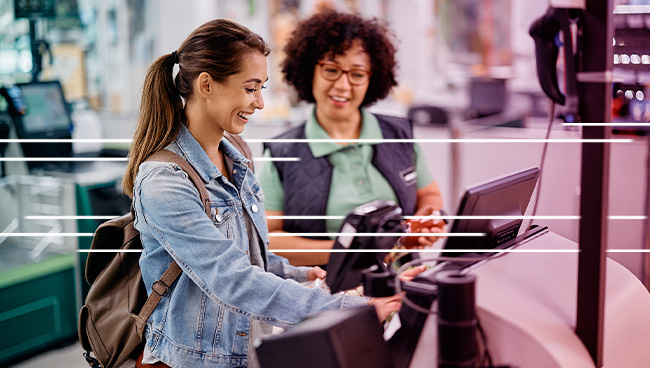More than eight in 10 shoppers prioritize price over convenience when choosing where to shop, our How America Shops® research shows. So how do they choose where to shop when prices are high everywhere? Ease could provide that competitive advantage, but shoppers tell us retailers have to get better at it.
When All Prices Are High, Does Ease Become More Important?
Consumer prices rose by 4% in 2023 and are expected to increase again in 2024 – by 3% . So it didn’t surprise us that 85% of shoppers in our How America Shops® survey said they put price before convenience when choosing where to shop[1].
However, ease still ranks up there. In fact, with prices high pretty much everywhere, convenience could now be a greater determining factor when shoppers choose where to make their next trip.
Here’s the dilemma: When we asked shoppers to rank a range of retailers on a scale of one to 100 for ease, not one mass retailer topped 70%. A breakdown of the attributes shoppers seek for convenience helps explain why.
Location, Location, And Many Other Factors
Yes, a store’s proximity remains very important to shoppers seeking convenience, especially when choosing where to make their big stock-up trips, our report, “Paradox of the New Shopping World,” finds. However, other attributes also factor prominently into their “easy shopping” choices.
And, importantly, these attributes shift in importance based on demographics. Here’s how shoppers ranked some of the most popular attributes of an easier shopping trip.
- In-and-out appeal – 47% of shoppers prioritize stores they know they can navigate quickly, with Gen X and Boomers at 50% and Gen Z and Millennials less – two out of five.
- One-trip attraction – Again, far fewer young shoppers rank a one-stop shop as most important for ease: just 36% of Gen Z and Millennials vs. while Boomers are +22 percentage points more likely to, and Gen X, +14 percentage points more likely.
- “No map needed” advantage – Nearly half of Gen X and Boomer shoppers seeking ease think it’s most important that they know where to find the items they want, vs. only one-third of Millennials and Gen Z .
- Self-checkout checks out – This is where Gen Z shoppers are – 47% rank self-checkout as most important for an easy trip. But here’s a surprise: Boomers are the second age group to value this factor most, trailing by 10 percentage points (37%).
- Online vs. paper coupons– 68% of shoppers use online coupons at least some of the time, with almost as many downloading them to their loyalty apps[2].
And about location – 52% of shoppers overall choose to shop a store because it is close to home or work, but that figure too varies sharply by age. Gen Z and Millennials are 14 to 20 percentage points less likely to prioritize a store by location than Gen X and Boomer shoppers[3].
Here’s How Retailers Ranked
We asked shoppers to rate 11 stores by 17 ease factors, including those above, and not one mass retailer scored above 70%. Here’s a look at how the top-three retailers fared, and how others rated[4].

3 Big Risks of Making Trips Less Easy
Our research has helped us determine that shoppers value low price but don’t also expect convenience. But what about the factors that block ease? Based on our How America Shops® interviews, here are the three biggest risks:
- Locked-up merchandise. Across the U.S., 70% of shoppers have encountered locked merchandise that requires a sales associate to unlock a case. While three-fourths will wait on their first encounter, one-fourth will not, and 30% will avoid that store in the future. This obstacle is especially daunting to Gen Z, 47% of whom are uncomfortable asking store personnel to help them with locked-up items – by nearly 20 percentage points more than total shoppers.
- Hitches at self-checkout. More than half of shoppers think using self-checkout is easier than going to a cashier. Any kinks in that process, therefore, could cost a retailer a significant sales in abandoned carts. Placing a helpful sales associate nearby to proactively resolve issues is a win for the store and the shoppers.
- Limited selections. Shoppers who can’t find what they want are less likely to come back; many may instead opt for the appeal of online sites that offer products they want, along with expert information and advice. Aisle maps triggered by a store’s app on entry is a solution already in place in DIY stores.
Finally, focus on associate culture. Employees can make a trip harder or easier by proactively offering to assist a confused customer – with the first step being to pay attention to customers’ facial expressions. Employees can nip disappointment in the bud by offering to direct shoppers to the right aisles and go further by offering to order products not in stock on the store’s website. They can keep the sale and earn points for caring.
Want to know more about what today’s shopper value most now, and next? WSL subscribers can access all of our How America Shops® research on our shopper research page. You can learn more about becoming a subscriber here.


